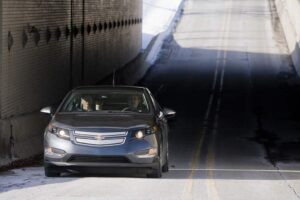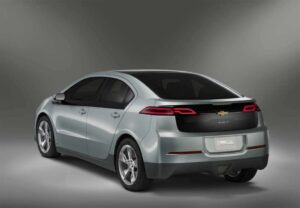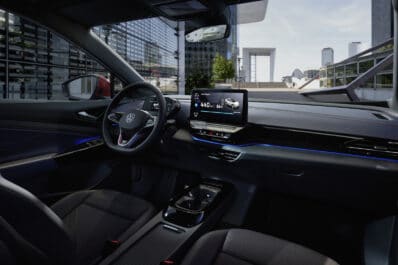
Few automobiles have ever received the hype and hoopla of the Chevrolet Volt, but now, almost exactly three years after it first rolled onto the stage at the 2007 Detroit Auto Show, the critical question is whether the production version will live up to expectations.
Most folks will have to wait until later this year to find out; the 2011 Chevy Volt won’t officially reach showrooms until sometime during the fourth quarter of this year. But after doing some pleading and offering up our first-born male child, TheDetroitBureau.com finally landed the opportunity to drive a near-ready Volt prototype on a recent, bitterly cold Detroit morning.
We met Andy Farah, the project’s chief engineer, out at the Vehicle Engineering Center, or VEC, a towering blue facility that provides a commanding view of the sprawling General Motors Technical Center, in the Detroit suburb of Warren. After sipping some tea and getting a quick “pre-flight” briefing, we eagerly jumped into the driver’s seat of the Volt prototype.

A little background is probably useful. Volt is, at its heart, a gasoline-electric vehicle. But it has some distinct differences from other hybrids, like Toyota’s popular Prius. The Japanese model has a very small nickel-metal hydride battery pack that is primarily used to recapture energy lost during braking and coasting, power then reused during acceleration. Prius – ad other conventional hybrids — can only drive for short distances and low speeds on battery power alone.

Not so the Chevrolet Volt, which is designed to be powered solely by its large lithium-ion battery pack for up to 40 miles and at speeds up to 90 mph. But unlike pure electric vehicles – such as the upcoming Nissan Leaf – Volt can keep going when the batteries run down. At that point, its compact four-cylinder engine automatically fires up. In an unusual design move, that gasoline-powered engine acts like a generator, sending power to the electric motors that drive Volt’s wheels.
The key takeaway is that this combination eliminates the so-called “range anxiety” associated with battery-electric vehicles, which are expected to deliver no more than 100 or so miles per charge. Sure, Volt can only get 40 before the batteries are run down, but that’s enough, data suggest, to more than satisfy the typical daily driving needs of 70% of American motorists. (And that’s why GM has chosen to dub Volt an Extended-Range Electric Vehicle, or E-REV, rather than a plug-in hybrid.)
Once inside the prototype, Farah cautioned us that this early model still had a few bugs: including a sticky driver’s window and interior detailing that wasn’t yet up to production standards. The “operating system,” the software designed to make everything work, was Gen 11, meanwhile, two generations behind the latest version. But if our morning drive was any indication of what’s to come, the 2011 Chevrolet Volt could charge up the market for battery vehicles.
Hit the Chevrolet Volt’s Start button and the initial experience is similar to that of a more conventional hybrid: all sorts of dials and gauges light up and a little warning tone finally indicates you’re ready to go, once you slip the large shift lever into “gear” (which engages Vol’s single-speed transmission).

Some years back, I was lucky enough to have dinner with the last man to walk the moon, Gene Cernan, and he mentioned the most surprising thing about sitting on the lunar surface was the complete silence. While driving a Chevrolet Volt doesn’t quite match that experience, I was just as surprised by the total lack of noise – until we pulled away from the VEC and began to hear snow crunching under our tires. Even under full throttle there was nothing more than a modest whine from the E-REV’s motor.
In normal mode, Volt delivered reasonable acceleration, launching from 0 to 60 in what we estimated to be around 10 seconds. But switched to Sport mode we got an unexpected jolt. Electric motors deliver maximum wheel-spinning torque the moment they start to turn, and with Volt, that translates into a very sporty launch feel and 0 to 60 times of about two seconds quicker.
Farah had intentionally given our prototype Volt just a limited charge, just enough so that we could experience the vehicle on battery power then have it automatically transition to extended-range mode – a fancy way of saying its inline-four-cylinder internal combustion engine fired up. The transition was all but seamless and even with the engine running, the cabin remained surprisingly quiet.
Once the gasoline engine fires up you can’t go back to EV, or battery, mode, Farah explained. But, like more conventional hybrids, the Chevrolet Volt will regenerate braking and coasting energy and use that to assist the I-4 gas engine during acceleration, further reducing fuel consumption.
We didn’t get much of an opportunity to push Volt to test handling, so we’ll have to wait until later this year for a more complete driving review, but we did find that there’s a nice direct feel to the electric steering and you feel well connected to the road.

When the original Chevy Volt concept car was unveiled, in January 2007, it boasted a truly distinctive design that, much like the Prius, gave it a stand-out appearance that wouldn’t be confused with more conventional small cars. Since then, GM engineers have made a number of modifications, much of that designed to enhance aerodynamics – yielding about five miles more on battery power than the original design would have gotten. As a result, the production version of Volt won’t be quite as distinctive, but it’s still visually a standout.
Making allowances for some prototype interior parts, the E-REV’s cabin is well outfitted, with a high-tech feel that’s sort of iPod-on-wheels. Most switches and knobs, for example, have been replaced with touch-sensitive controls, though there are small bumps to give a driver some tactile feedback. The one drawback to the interior is the limited headroom in the rear, though there’s plenty of backseat legroom.
As most hybrid owners have discovered, there’s a learning curve, especially if you want to maximize mileage. The curve will be even more significant with mre advanced vehicles: plug-in hybrids, E-REVs and pure battery-electric vehicles, or BEVs.
For one thing, you’ll have to charge up, most likely overnight, drawing power from any AC outlet, though GM will encourage Chevrolet Volt buyers to install a 220-volt quick charger that will “refill” the batteries in just a few hours. (The automaker is lining up partnerships with a number of major utilities around the U.S. to make it easier to get those chargers installed.)
Owners will also learn that 40 miles is an estimated average on battery power. If you have a heavy foot and drive like we did with the Volt prototype, you’ll get less mileage per charge. Range on battery power also will be impacted by a driver’s use of headlights and climate control. Electric heating draws a lot of current.
Will Volt turn on potential buyers? If our drive in the prototype was any indication, it likely will. It’s well suited to the mass of American commuters.

The real question is whether motorists will be turned off by Volt’s price tag. While Chevy isn’t saying, it’s expected to bring the E-REV in somewhere around $40,000 – before a $7,500 federal tax credit, which would translate into the low $30,000 range, still well above a comparable model with a conventional drivetrain.
Of course, rising gas prices could enhance the appeal of the 2011 Chevrolet Volt. At current fuel costs, electricity is a bargain, and if the pump hits $4 a gallon, you’ll spend barely a tenth as much per mile on electricity. Considering the vast majority of U.S. motorists could go months without a visit to the gas pump, that alone may prove to be an unbeatable proposition.








Sounds like techno fun but will that estimated $10,000+ price premium over a comparably equipped Chevy Cruze prove to be too much of a stretch for most people who have a hankering to go green? Will they settle for a less expensive Prius or lay out some more green for the next generation Fisker or Tesla? Of course, the Volt will bring potential buyers into the showroom and even if some drive away in a Cruze the extra traffic could electrify sales.
What’s the absolute driving range of the Volt? After the battery is depleted, when do you need to refuel for the gasoline engine?
It’s great you got to drive the whole package, and write about it.
However, you typo-ed and called a Chevy Colt!
The answer to my question:
The car is being designed to drive at least 40 miles on pure electricity stored in the battery from overnight home charging. After that the gas engine will kick in and allow the car to be driven up to 400 miles on a full tank (~8 gallons) of gas.
400 miles on 8 gallons of gas? 50 MPG?
I think the price is to high for the average buyer.
Hi, Terry,
You’re very likely right…though we still don’t know what the final figure will be. Do be aware that for the foreseeable future, all battery vehicles will carry a premium — unless the manufacturer consciously decides to subsidize the cost, as most analysts believe Toyota did with the first-generation Prius. Battery prices are expected to fall by anywhere from 60 to 80%, this coming decade, but it’d likely be no sooner than 2020 before we see a battery-electric or battery-hybrid powertrain match the comparable cost of a traditional IC drivetrain.
That said, one must consider more than the out-the-door cost. That gasoline you pump is costing you anywhere from 8 to 20 cents a mile, depending on where you live, what you drive, how you drive, and so on. Let’s go with 10 cents over 15,000 miles a yer, for argument’s sake, and that adds up to $1,500 annually, but for many folks, it’s more like $2,500. Keep a car seven years (the U.S. norm) and that means somewhere between $10,000 and $17,500 — at current fuel prices. Bump the pump price to $4.00, as many expect and, well, you can do the math.
Now, let’s say you get a Volt at $32,500 (using the anticipated price minus the $7,500 federal tax credit), and you are using a utility that will give you an off-peak charge rate, which many anticipate to be 1 or 2 cents/mile. If you use electric power for 90% of your annual driving, which appears to be a reasonable projection for Volt buyers, you’d spend about $150 on gasoline and roughly the same or slightly more for electricity, or $300-400 annually. Over 7 years, that’s may work out to a savings of $7,000 to more than $15,000. And, suddenly, the added up-front purchase price wouldn’t see so bad. This is, essentially, the same sort of calculation I tell folks they need to do when considering a hybrid, like the Prius, Insight or Escape Hybrid.
Paul A. Eisenstein
Publisher, TheDetroitBureau.com
We live in Wisconsin with snow and ice. Iam a retired from the Janesville plant. We now have 2004 Pontiac 60K will wait for the VOLT to hit the dealers.That is our plan. Bring it on as we my Wife are excited and want the VOLT in the driveway or garage soon as possible.
“400 miles on 8 gallons of gas? 50 MPG?”
Yes, but if your round trip to work is 40 miles or less and this is what you use the car for 90% of the time then how many miles per gallon are we talking about?
Ah, Jim, that’s the rub. You may recall that late last year GM posted billboards claiming an mpg rating that reached into the 100s for the Volt. There was some pretty harsh feedback and, notably, Nissan decided not to promote an even higher figure for its battery-electric Leaf. How do you calculate mpg? Even with an internal combustion engine the math is more complicated than it might seem. Allow your engine to run on E85, for example, and you get huge credits, at least in the numbers the government considers for compliance. There can be an entirely different number shown on the window sticker. With alternative propulsion, and especially with a vehicle, like Volt, designed to run part-time on battery, part-time on gasoline, the calculus gets even more complicated. For their part, some members of the Volt team anticipate that many owners will seldom, if ever, go beyond the 40 mile battery range. If so, you could argue their mileage is “infinite.” Of course, unless a battery vehicle is drawing power from a truly green source — wind, wave or solar — or from nuclear, there is some form of fossil energy involved, so that just adds another factor to the equation.
Paul A. Eisenstein
Publisher, TheDetroitBureau.com
why won’t the small ewngine recharge the battery?
also what is the batery life and what will it cost to replace?
Hi, Garrett,
A question I asked, as well. GM’s point is that the lowest-cost way to charge the battery is to plug Volt in. If you use the gasoline engine, the cost just goes up and you might as well run the car directly off the internal combustion engine. The reality is that even as Volt’s battery discharges it will still be slightly recharged each time the sedan brakes or coasts, but that won’t generate enough power to switch back to electric drive mode. Instead, that small amount of recovered energy will be used like on a conventional hybrid, such as Prius. In other words, to give you a boost during take-off or hard acceleration.
Meanwhile, it’s unclear what the cost of replacement will be, but as we expect Chevy will provide a minimum 10-year/100,000-mile warranty, battery costs should be a lot lower by the time early Volts actually need a replacement.
For a primer on battery car pricing, check out this new story:
http://www.thedetroitbureau.com/2010/03/should-you-buy-a-hybrid-or-battery-car/
Paul A. Eisenstein
Publisher, TheDetroitBureau.com
Hi Paul,
The point I was trying to make is that you can’t really put a MPG on the Volt because it will be so different for everyone depending on how they use the Volt.
Agreed, Jim, but you can’t just put “whatever,” or “really good” on the Monroney sticker, so the question is whether the feds come up with something reasonably intuitive. And then, per your point, folks will need to know, as the old line goes, “mileage may vary.” Widely, in he case of the Volt.
Paul E.
Hi Paul,
I see your point.
Paul some new terminology is needed with electric drive… “slip the large shift lever into gear” is now redundant assuming the Volt uses a reversible motor. As in the Prius there is no forward or reverse gear only a selector for choosing direction.
I am also curious as to your take on the generator, are the revs very high and at a steady rpm, or does it vary according to the load i.e. the accelerator position?
Does the gen supply directly to the motor after battery depletion or through the pack to the motor? I would assume if the ICE varies revs with the accelerator it supplies the motor directly and if not its through the battery. Its important for readers to know that when the pack is depleted its not flat but has reached a predetermined discharge safety point with probably 20 to 30% charge still left. This prolongs the life of the pack and is true with the current hybrids as well.
Sure wish I had been riding shotgun with you on that test.
Hi, D,
You’re right about needing alternative terms, though I think we’ve all accepted that we still “dial” the phone, and so “shifting gears” is likely to remain a part of our lexicon for years to come. And I would be surprised if, going forward, automakers don’t try to recreate the feel of shifting gears, much as they have done with some of the current crop of CVT transmissions.
As to your questions regarding the function of the Volt’s ICE generator, (an I-4 gasoline-powered internal combustion engine, for those less into the lingo), I think I’d best turn this over to the members of the Volt team and ask them to fill us in, rather than try to answer myself and get it wrong. I’ve e-mailed one of my key contacts and am hoping he or someone else from Volt will reply.
Paul A. Eisenstein
Publisher, TheDetroitBureau.com
Thanks for that I will keep on the lookout for your response. Its funny you should mention creating the feel of shifting gears when thats just what Lotus has done on its concept EV with a steering wheel paddle shifter. Of course this is the same company suggesting the use of a conventionsal engine sound for their electric sports car. I’m lost for words!
LOL, D, you’ve reminded me of the Smart preview at the 2009 Geneva Motor Show. The maker’s neon green Brabus concept featured an electric drivetrain synced up with an external audio system. While it may sound funny, the fact is there are serious concerns about the lack of noise created by an electric drivetrain. My own wife was nearly hit by a hybrid running in battery mode, recently. Smart’s system produced a very Brabus-like V8 roar when you stepped on the little car’s throttle. Or you could flick a switch and make it sound like the car from the old cartoon, the Jetsons.
It’s ironic that we’ve long wished that we could quiet down cars, especially on urban streets, but I wouldn’t be surprised to see some sort of mandate that sets a minimum level of noise battery cars MUST make to alert pedestrians.
And as for the shifter, we don’t give up the familiar very readily. Even though the better gearboxes can now change gears in milliseconds, makers like Porsche and Ferrari still offer sticks or paddles. I don’t expect that to change with electrified sports cars.
Paul E.
Point is the Porsche and Ferrari have gear boxes and the paddle shifter is a more efficient way to shift without removing your hands from the wheel.
An electric has no gearbox for changing ratios or any need for one and to provide a paddle shift is gratuitous.
I can see them installing a clutch pedal next!